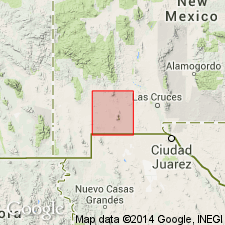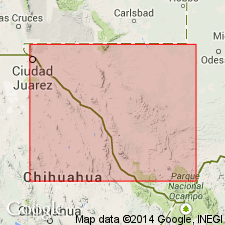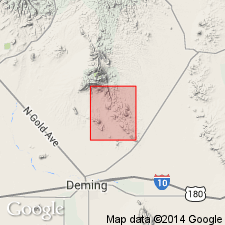
- Usage in publication:
-
- Gym limestone*
- Modifications:
-
- Original reference
- Dominant lithology:
-
- Limestone
- AAPG geologic province:
-
- Basin-and-Range province
Summary:
Pg. 19, 35. Gym limestone. Chiefly light-gray limestone, in greater part massively bedded, showing brecciated structure in many beds. In Gym Peak (type locality) and vicinity the lower member is dark, and the one next above of much lighter color, with abrupt change between them, and thickness there is at least 700 feet. Occurs in central and southeastern parts of Florida Mountains and central part of Victorio Mountains and extends part way around northern end of Tres Hermanas Mountains, Deming region, southwestern New Mexico. Total thickness near 1,000 feet. Rests unconformably on Magdalena, Lake Valley, and older formations and is unconformably overlain by Lobo formation (Triassic?) or Tertiary agglomerate. Fossils discussed. Age is Permian (Manzano).
Type locality: Gym Peak [in NE/4 NE/4 sec. 12, T. 26 S., R. 8 W., approx. Lat. 32 deg. 03 min. 58 sec. N., Long. 107 deg. 36 min. 17 sec. W., Gym Peak 7.5-min quadrangle, Florida Mountains, Luna Co., southwestern NM (USGS GNIS database and USGS historical topographic map collection TopoView, accessed on September 9, 2023)].
Source: US geologic names lexicon (USGS Bull. 896, p. 893).

- Usage in publication:
-
- Gym formation
- Modifications:
-
- Areal extent
- AAPG geologic province:
-
- Permian basin
Summary:
In the Permian basin (Hudspeth County, Texas), west and south of the Sierra Diablo, the Permian normal marine facies passes abruptly into a dolomitic facies with an impoverished fauna. The limestones and dolomites of this facies are the Gym formation. This term is extended from the Deming area of southwestern New Mexico, where the name was proposed by Darton (1916) for rocks of the same age and facies. Rocks of Gym facies are found in the Wiley, Carrizo, Van Horn, and Eagle Mountains south of Van Horn. They make up the bulk of the Diablo Plateau, extending east to within a few miles of the rim of the Diablo Range, where they intergrade with the normal marine facies. Gym is also exposed in the Hueco Mountains, the Franklin Mountains, and near Deming, New Mexico. It constitutes the upper part of the Naco limestone of southern Arizona. Gym fauna is impoverished, made up of gastropods, pelecypods, and a few brachiopods, including especially COMPOSITA MEXICANA and PUGNOIDES TEXANUS. Basal beds in Hueco and Franklin Mountains also contain plentiful SCHWAGERINA. This lower part of the formation may be either upper Wolfcamp or lower Hess age; probably former. Near New Mexico state line, Gym limestones of Diablo Plateau interfinger with Chupadera formation. A few tongues of this facies extend south of the boundary into Texas; a red-bed member lies between limestones in upper part of Gym of Hueco Mountains, and thick gypsum layers are interbedded with Gym southeast of Cornudas Mountains. Age is Permian.
Source: GNU records (USGS DDS-6; Denver GNULEX).

- Usage in publication:
-
- Gym Limestone*†
- Modifications:
-
- Abandoned
Summary:
Darton (1916, 1917) mapped some Pennsylvanian rocks in the Florida Mountains, the Victorio Mountains, and the "Tres Hermanos Mountains" of southwestern NM as Gym Limestone of "late Carboniferous age". Studies by Kelley and Bogart (1952), Bogart (1953), and Jicha (1954) have shown that: 1) the Gym Limestone at the type locality in the southern Florida Mountains contains beds ranging in age from Silurian to Cretaceous?; 2) the restricted Gym is equivalent to Hueco Limestone; and 3) the name Gym Limestone should be abandoned. Jicha (1954) mapped equivalent Pennsylvanian rocks in the adjacent Lake Valley quad as Magdalena Group. Brachiopod and fusulinid faunas indicate a Middle Pennsylvanian (Desmoinesian-Missourian) age (Jicha, 1954; Kottlowski, 1958).
Source: GNU records (USGS DDS-6; Denver GNULEX).
For more information, please contact Nancy Stamm, Geologic Names Committee Secretary.
Asterisk (*) indicates published by U.S. Geological Survey authors.
"No current usage" (†) implies that a name has been abandoned or has fallen into disuse. Former usage and, if known, replacement name given in parentheses ( ).
Slash (/) indicates name conflicts with nomenclatural guidelines (CSN, 1933; ACSN, 1961, 1970; NACSN, 1983, 2005, 2021). May be explained within brackets ([ ]).

